Smoke an Easter Lamb Shoulder on a Charcoal Grill
My religious upbringing was, in a word, confusing, so the Easters of my youth were very basket-focused. My mom still send me Easter packages, but I have not been inside a church in I don’t know how many years. I do appreciate Easter food, however, and Passover food, for that matter. I just like food, especially when the food in question is a large piece of meat.
I come from a ham family. We ate ham on Easter, Thanksgiving, and Christmas, and I liked it. I never asked my mother to prepare a different meat, though my sisters may have, because they don’t like ham for some reason (bad palates).
I didn’t even know lamb was a common Easter meat until I was in my 20s, around the same time I tasted my first baby sheep at a churrascaria in Tampa. I loved it. Lamb is a meat that does not let you forget, even for a second, that you are eating meat. You cannot force lamb into a sterile little unit. You cannot fashion it into a tender or shape it into a dinosaur nugget to make it less visceral. You can grind it and press it into a patty, but even then, you will never forget that you are eating an animal. (I think that’s a good thing.)

And while I will never abandon cured pork, I do highly recommend smoking a boneless lamb shoulder for your Easter or Passover dinner. One advantage lamb has over ham is that it works for both holidays.
The procedure for smoking a lamb shoulder is almost identical to the procedure for smoking a pork butt. Both have a lot of intramuscular fat and collagen that need lots of time to break down, and both do best when cooked low and slow. You can also smoke both cuts without a “proper” smoker. We’re going to be focusing on a simple charcoal setup using a Weber Kettle (or similar grill) equipped with an external digital thermometer. Other than that, you’ll need some briquettes, some wood chips, a drip pan, and a boneless lamb shoulder.
Set it up
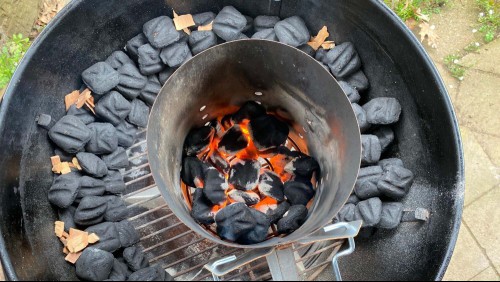
Before we get to the meat, let’s talk about your set-up. You will need:
A charcoal grill
A charcoal chimney
Lighter cubes (or wadded up newspaper)
Charcoal
Wood chips (I used apple, but feel free to play around with different woods)
A drip pan
A dual probe thermometer
You may think you don’t need a thermometer, but you are wrong. Unless you have been smoking those meats for a while—in which case, this is probably not the blog for you—having a thermometer is the only way you will be able to know what’s going on inside your grill and inside your meet. As I have mentioned previously, the little dial thermometer that sits on the dome of your grill is wildly inaccurate (especially when positioned over hot coals), and it’s impossible to control the temperature if you don’t know the temperature. This $30 model works fine, but getting one with Bluetooth capabilities means you don’t have to keep dashing out to the yard to check your temps.
Once you’ve gathered all of your equipment, you’ll need to make a charcoal snake. The snake is also the configuration I used to smoke my pork butts and my turkeys, but just to re-cap:
The Snake” is a charcoal stacking method where you literally snake your briquettes around the outside of your grill, then light one end and let the coals slowly burn throughout the day. (Yes, you could “just get a Slow ‘n’ Sear,” but I think knowing how to do this without that particular attachment is valuable knowledge.) There are a few variations on this theme, but I found that a rough 24 briquette-long snake of coals, stacked two high and two wide, with some single coals along the top of the snake, was just—and I mean
just
enough to fully cook my nearly eight-pound pork shoulder. I will probably add a little more next time—there were no unburnt coals remaining when I opened my grill, and that last bit of cooking was done with the pure residual heat.
In addition to charcoal, you’ll also need some wood chips. I used applewood, and placed 3-4 smallish chips in between the coals on top of the snake, with the majority of the wood at the beginning of the snake, and more space between wood piles towards the end.
Somewhat serendipitously, a “rough 24 briquette-long snake of coals, stacked two high and two wide, with some single coals along the top of the snake” is also the perfect amount of charcoal for a 3-4 pound lamb shoulder.
It should look a little something like this:
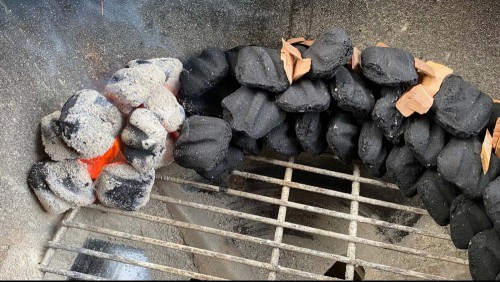
I like to set my snake up the day before, after I salt my meat and get it in the fridge for an overnight dry brine (more on that in a bit). Having the charcoal snaked and ready to go takes one thing off of you day-of to-do list.
Salt before you rub (or smear)
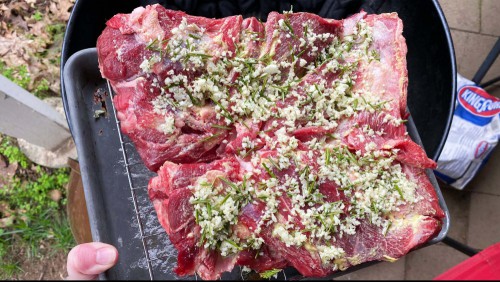
Flavoring your lamb is a process that works best when broken down into two steps: salting and everything else. As I mentioned in the pork butt blog, this has to do with the relative size of the molecules responsible for flavoring:
Salt is a small molecule, and it permeates the meat with ease. Most of the flavor molecules in a rub, however, are much larger, and they cannot penetrate deep into the meat. (According to
AmazingRibs.com
, most rub ingredients only make it around an 1/8th of an inch below the surface.) That’s fine. In fact, that’s exactly what you want a rub to do—sit on the surface and create a beautiful bark of complementary flavors, but it does mean you should treat salting and rubbing as
two different flavoring steps
.
Start by salting your lamb the night before. If your lamb shoulder came trussed in a neat little roll, go ahead an unroll it, and season both sides of every strip. These two pieces of lamb will be a lot thinner than a whole pork shoulder, so you won’t need to go quite as hard. You want your meat to sparkle with salt, without looking completely crusted over. The amount of Kosher salt you see on the lamb below was just enough, but I could have been slightly more aggressive. (I really like salt, though.)
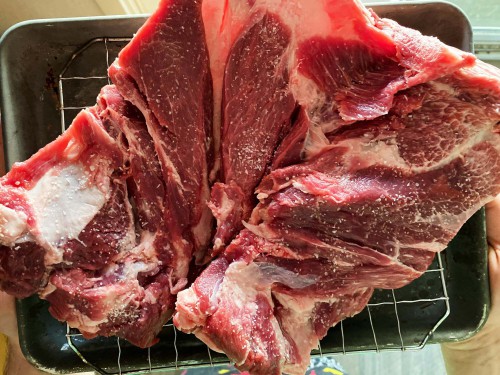
Once salted, set the meat on wire rack set inside a rimmed baking sheet and let it hang out overnight, or up to 24 hours. Apply your rub just before smoking.
If, however, you want to get some garlic and herbs involved, you can pulverize them and spread them on the side of each strip of lamb, then roll both pieces back into a neat little package. (I like to brush a little Dijon mustard on meat to help the plant bits stick.)

I had initially gone the “stab the lamb with a sharp knife and shove a whole bunch of cloves into its flesh” route, and that did result in some very tasty, spreadable smoked garlic, but the garlic didn’t have a chance work itself into the lamb.
You don’t need a ton of herbs or garlic. I used three sprigs worth of fresh rosemary needles and eight cloves of garlic—just enough to provide complementary flavors without overpowering the lamb. (I like to let the meat speak for itself.)
Anticipate the stall
The stall is a tricky thing. Sometimes it happens around 150℉, sometimes it happens around 170℉, and sometimes it doesn’t happen at all. The first (almost three-pound) lamb shoulder I smoked took about seven hours to reach 190℉, while the second one, which weighed just under four pounds, took a little over 10 hours to hit 183℉.
According to AmazingRibs.com, the culprit is water—moisture evaporates during cooking, cooling the meat just like sweat cools our bodies on a hot day—and there are a few tactics you can take to combat the stall:
That’s [the stall] because the moisture evaporating from the surface is cooling the meat at the same rate as the hot air is warming it, and the internal temperature stalls. You can just ride it out, or you can bust through the stall by cranking the heat to about 300°F or by wrapping the meat tightly in foil.
I always combat the stall by opening the vents up a little bit to drive the heat up into the range of 300℉-325℉. (I have never wrapped the meat tightly in foil because I have never wanted to deal with all of that.)
Control your temperature
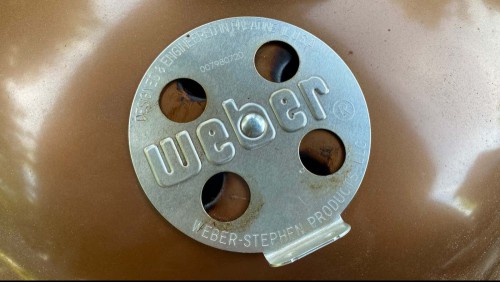
Unlike a gas grill, there are no dials that let you control the heat coming off of your coals. Fire requires oxygen, and the more oxygen you provide for your coals, the hotter they will get. Instead of dials, you have vents below and above the coals, and those vents let you control the air flow through your grill (and thus the heat).
We’ve discussed vents and air flow before, but just to recap:
A lot of people have a lot of opinions on exactly where you should set your intake and exhaust dampeners, but it doesn’t really matter, as long as you find a setup that keeps your internal grill temperature between 225℉ and 250℉.
I like to start with the intake dampener (the one on the bottom) completely open, with the exhaust dampener (on the top of the lid), about halfway open, then close it to just a sliver once the ambient temperature inside the grill breaks 200℉.
You’ll probably have to fiddle a little more than that, but try not to fiddle too much, and wait 30 minutes in between adjustments. About halfway through the cook, you may be tempted to open the grill and take a peek to see “how things are going.” Don’t do this! You’ll release a bunch of heat and moisture. Remember: If you’re looking, you’re not cooking.
But don’t get hung up on a target temp
Most smoked lamb shoulder recipes tell you to cook the lamb until it reaches an internal temperature somewhere in the range of 190℉-200℉. Only one of the shoulders I cooked made it into this range, and the one that didn’t—the one I took off at 183℉ because it had been on there for 10 entire hours—was actually the better of the two.
How could this be? Collagen starts melting at 160℉, and continues to do so until it hits 180℉, transforming these structural proteins into rich, silky gelatin. This gelatin—along with rendered fat—will saturate the meat, making it nice and juicy.
As long as your lamb spends a good amount of time in that 160℉-180℉ range, it will be juicy, tender, and delicious. The second lamb shoulder I cooked (the one that only got to 183℉) spent at least two hours more in that range than the first one, mostly due to its stall, and it was the better for it. You can’t control when and at what temp your meat will stall (and it might not stall at all), but try to keep your heat as close to 225℉ as possible for as long as you can (and don’t let it exceed 250℉). And don’t worry if you can’t get your shoulder much above 180℉—it will still be delicious.
Let’s cook the thing
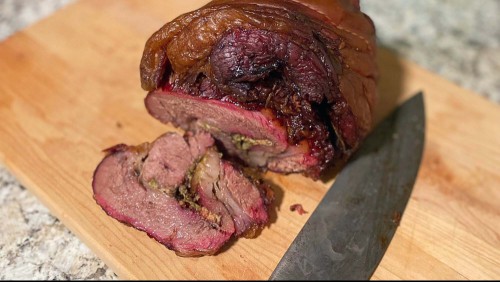
To smoke your very own lamb shoulder, you will need:
1 3-4-pound boneless lamb shoulder
Salt
1 tablespoon of Dijon mustard
3-4 sprigs rosemary, needles removed from the stem
8 garlic cloves
Rub (if using)
The day before you plan to smoke your shoulder, take it out of the fridge, unroll it, and salt the lamb on all sides. You want it to sparkle with salt, but you should still see some meat peaking through. Set the lamb on a wire rack set inside a rimmed baking sheet, and return it to the fridge for 12-24 hours.
You can also set up your grill the night before. Arrange your charcoal in the snake formation as shown above. Your snake should be at least 24 briquettes-long, stacked two high and two wide, with some single coals along the top of the snake. Add your wood chips, a few every couple of briquettes, with most of them towards the beginning of the snake, and fewer on the latter half. Close the grill until the next morning. (Allow at least eight hours for cook time, but be prepared for it to finish anywhere in the 6-10 hour range.)
Remove the lamb from fridge, and paint the “inside” of each lamb segment with Dijon mustard. Blitz the garlic and rosemary together in the food processor, then press the mixture into the mustard. Place the inner piece of lamb on top of the outer piece, and roll it all up and secure with kitchen twine. Apply your rub, if using.
Fill your chimney about 1/3 of the way full with charcoal, and light a lighter cube or some newspaper underneath the coals. Once the coals are mostly ashed over, dump them at the beginning of the snake (the side with more wood chips), set a drip pan in the center of your snake, and fill it about halfway with boiling water.
Set the grill grate over the snake, and set the lamb shoulder over the drip pan in the center of the grill. Stick one thermometer probe in the thickest part of lamb, and another probe on a clip to measure the ambient temperature of the grill, next to the lamb, but not touching it. Close it up with the exhaust vent opposite from the hottest coals, open the intake dampener fully, and the exhaust dampener halfway.
Once your grill temperature reaches around 200℉, adjust your exhaust dampeners so they’re opened just a sliver. Let the temp stabilize, and adjust more if needed. If you need your temperature to rise, open the top vents a little more; if you need it to fall, close the bottom vents a bit (as you probably cannot close the top anymore without closing them completely). Keep an eye on the temp and make small adjustments as needed to keep things between 225℉ and 25o℉.
Smoke until your pork reaches an internal temperature of at least 180℉ (and up to 195℉), rotating the lid every once in a while to keep the exhaust vent on the opposite side from the burning coals. (You won’t be able to see exactly where the coals are burning, so just move it a couple of inches every hour and a half or so.) Temp-wise, I know some people like to go higher, but none of my shoulders have ever broken 200℉, and all have been incredibly tender, juicy, and delicious. As long as the meat can be easily pierced with a probe, you should be good.
Claire is Lifehacker's Senior Food Editor. She has a B.S. in chemistry, a decade of food journalism experience, and a deep love for mayonnaise and MSG.
RECOMMENDED NEWS

Turn Ferrero Rocher Chocolates Into Spooky Halloween Candy
Ferrero Rochers are too pretty for Halloween—too fancy, too golden, too...nice. Fortunately, there a...

14 Ways to Get Weird With Cranberries
For such a simple condiment, cranberry sauce is quite the lightening rod. I have never been able to ...

Keep This Easy Fried Garlic on Hand at All Times
Garlic is a crucial ingredient in various cuisines around the world. Maneul jangjji is a popular pic...

Make Sweet & Sour Sauce With Apricot Preserves
My favorite sweet & sour sauce is the McDonald’s variety. It comes in a little plastic tub with a br...

How to Fix a Too-Sweet Cranberry Sauce
Cranberry sauce is supposed to be a balance of sweet and tart. The sauce acts as a cleansing port in...

You Need These Yogurt Cup Biscuits
Biscuits can stir up a great deal of tension when you suggest tinkering with a traditional recipe. W...
Comments on "Smoke an Easter Lamb Shoulder on a Charcoal Grill" :